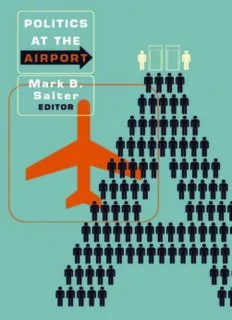
Politics at the Airport PDF
Preview Politics at the Airport
P A OLITICS AT THE IRPORT This page intentionally left blank P A OLITICS AT THE IRPORT Mark B. Salter, Editor University of Minnesota Press Minneapolis • London Portions of chapter 2 were previously published in David Lyon,Surveillance Studies: An Overview(Cambridge: Polity,2007); reprinted with permission of Polity Press. Copyright 2008 by the Regents of the University of Minnesota All rights reserved.No part of this publication may be reproduced,stored in a retrieval system,or transmitted,in any form or by any means,electronic,mechanical,photocopying, recording,or otherwise,without the prior written permission of the publisher. Published by the University of Minnesota Press 111 Third Avenue South,Suite 290 Minneapolis,MN 55401-2520 http://www.upress.umn.edu Library of Congress Cataloging-in-Publication Data Politics at the airport / Mark B.Salter,editor. p.cm. Includes bibliographical references and index. ISBN 978-0-8166-5014-9 (hc : alk.paper)—ISBN 978-0-8166-5015-6 (pb : alk.paper) 1.International airports—Security measures.2.Terrorism—Prevention.I.Salter,Mark B. HE9797.4.S4P65 2008 363.12'4—dc22 2008009095 Printed in the United States of America on acid-free paper The University of Minnesota is an equal-opportunity educator and employer. 15 14 13 12 11 10 09 08 10 9 8 7 6 5 4 3 2 1 C ONTENTS Acknowledgments vii Introduction: Airport Assemblage ix Mark B.Salter 1. The Global Airport: Managing Space,Speed,and Security 1 Mark B.Salter 2. Filtering Flows,Friends,and Foes: Global Surveillance 29 David Lyon 3. Unsafe at Any Altitude: The Comparative Politics of No-Fly Lists in the United States and Canada 51 Colin J.Bennett 4. Mobility and Border Security: The U.S.Aviation System, the State,and the Rise of Public–Private Partnerships 77 Gallya Lahav 5. Airport Surveillance between Public and Private Interests: CCTV at Geneva International Airport 105 Francisco R.Klauser,Jean Ruegg,and Valérie November 6. Travelers,Borders,Dangers: Locating the Political at the Biometric Border 127 Benjamin J.Muller 7. Mobilities and Modulations: The Airport as a Difference Machine 145 Peter Adey 8. Welcome to Windows 2.1: Motion Aesthetics at the Airport 161 Gillian Fuller Contributors 175 Index 177 A CKNOWLEDGMENTS The workshop where these chapters were first presented,“Moving Targets: Politics of/at the Airport,”was held with the support of the Globalization of Data Project,part of the Queen’s University Surveillance Project.With fund- ing from the Social Sciences and Humanities Research Council of Canada, David Lyon and I were able to bring together scholars from Europe, America,and Canada for serious conversation on the theme of the airport. We were fortunate to hold the conference concurrent with the first Canadian Aviation Security conference,with the support of the Canadian Air Transport Security Authority and the Canadian Advanced Technology Alliance.In par- ticular,we would like to thank Tom Hodge,John Stroud,Norm Kirkpatrick, and Jacques Duscheneau for their constant encouragement and commitment. We also thank Debbie Lisle and Heather Cameron,who participated in the workshop but were unable to contribute to this volume. An individual research grant from SSHRC and support from the University of Ottawa have also been invaluable to my own work in this area. David Lyon has been a keen supporter of this project,and I would like to acknowledge his open attitude, hard work, thoughtful advice, and fre- quent encouragement.The contributors to this volume have been extremely generous with their time and intellectual energy, which is greatly appreci- ated.The assistance of Joan Sharpe was key to the success of both the work- shop and the subsequent book.Danielle Topic provided a keen editorial eye in the presentation, collation, and production of this manuscript. I also thank Pieter Martin and two reviewers at the University of Minnesota Press for their enthusiasm for this project. Mark B.Salter Ottawa,Canada vii This page intentionally left blank Introduction A A IRPORT SSEMBLAGE Mark B. Salter Few sites are more iconographic of both the opportunities and the vulnera- bilities of contemporary globalization than the international airport. The popular imagination is filled with images of postmodern hubs that cater to the contemporary road warriors and global nomads that philosopher Peter Sloterdijk and architect Rem Koolhaus haved dubbed the “kinetic elite.”1 Cities unto themselves—with all attendant institutions, social forces, poli- tics, and anxieties—airports are both an exception to and paradigmatic of present-day life.Using a Foucauldian frame,they can be understood as “het- erotopias,”social spaces that are “in relation with all other sites,but in such a way to suspect,neutralize,or invert the set of relations that they happen to designate, mirror, or reflect.”2 Airports are national spaces that connect to international spaces, frontiers that are not at the territorial limit, and grounded sites that embody mobility.3 In addition to being local sites of contestation,airports are representa- tive of supermodern “nonplaces” in which social relations are based on mobility rather than fixity.4As J.G.Ballard writes,“airports have become a new kind of discontinuous city, whose vast populations, measured by annual passenger throughputs, are entirely transient, purposeful, and for the most part happy. Above all, airports are places of good news.”5 The glamour and exoticism of the airport as a gateway to other places and the ix
Description: